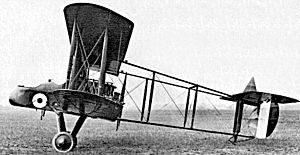Frederick Thayre facts for kids
Quick facts for kids
Frederick James Harry Thayre
|
|
|---|---|
| Born | 20 October 1894 London, England |
| Died | 9 June 1917 (aged 22) Warneton, France |
| Commemorated at |
Arras Flying Services Memorial, Pas de Calais, France
|
| Allegiance | United Kingdom |
| Service/ |
British Army |
| Years of service | 1915–1917 |
| Rank | Captain |
| Unit | No. 16 Squadron RFC No. 20 Squadron RFC |
| Battles/wars | World War I • Western Front |
| Awards | Military Cross & Bar |
Captain Frederick James Harry Thayre was a brave British pilot during World War I. He was born on October 20, 1894, and sadly died on June 9, 1917. He became known as a "flying ace" because he and his observer-gunners shot down twenty enemy aircraft. This made him one of the top pilots of his time.
Contents
Who Was Frederick Thayre?
Frederick James Harry Thayre was an amazing pilot. He was a British "flying ace" in World War I. This means he was a pilot who shot down five or more enemy planes. He achieved 20 victories with his partners.
Early Life
Frederick Thayre was born in London, England. This happened on October 20, 1894. Before the war, he lived in a town called Littlehampton in Sussex.
Becoming a Pilot
Frederick learned to fly even before joining the military. He earned his pilot's license on July 29, 1915. On the same day, he joined the Royal Flying Corps (RFC). The RFC was the air force of Britain during World War I. He became a second lieutenant. After more training, he became a flying officer in December 1915. By July 1916, he was made a flight commander. This gave him the temporary rank of captain.
Flying in World War I
Frederick Thayre's first flying missions were with No. 16 Squadron RFC. He flew a two-seater plane called a B.E.2. These planes had two seats: one for the pilot and one for an observer. The observer would also operate a machine gun.
First Victories
Frederick got his first victory on March 18, 1916. His observer, Lieutenant C. R. Davidson, shot down a German Fokker E.III fighter. For his bravery, General Douglas Haig praised him. This was called a "mention in despatches." It meant he was recognized for his excellent conduct.
Teaming Up with Cubbon
Later, Frederick joined No. 20 Squadron. Here, he flew a different plane, the F.E.2d. He formed a strong team with his observer, Francis Richard Cubbon. Together, they were incredibly successful. On May 1, 1917, they shot down an Albatros plane. They even fought against 26 enemy planes on May 3, 1917. They shot down two of them. When they ran out of machine gun bullets, they used their pistols!
Throughout May 1917, Thayre and Cubbon achieved fifteen victories together. They became one of the most successful teams.
A Hero's End
On June 7, 1917, Thayre and Cubbon shot down another enemy ace. This was Leutnant Weissner, who had five victories. Just two days later, on June 9, 1917, tragedy struck. Their F.E.2d plane was hit by anti-aircraft fire. This happened near Warneton, France. Both Frederick Thayre and Francis Cubbon were killed.
Together, they had 19 victories. This included five planes shot down in flames. They also destroyed eleven others. Frederick's first victory with Davidson made his total 20.
Awards for Bravery
After their deaths, Frederick Thayre and Francis Cubbon were honored. They both received the Military Cross. Frederick also received a "Bar" to his Military Cross. A Bar means he earned the award a second time. These awards recognized their incredible bravery and skill.
The Military Cross was given for his "conspicuous gallantry and devotion to duty." It praised his "fine offensive spirit." The Bar was awarded for his "fine leadership and skill." It noted how he brought down three enemy machines. He showed great courage against many enemy planes.


